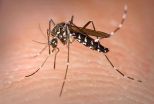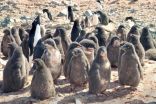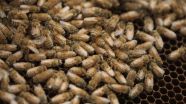(Press-News.org) Difficulty in conceiving a child is a major challenge for one in seven heterosexual couples in America, especially for those over the age of 35. Now a new discovery by researchers at Tel Aviv University and Chaim Sheba Medical Center at Tel Hashomer could boost the chances of conception in women undergoing in vitro fertilization (IVF) treatments.
Their new research reveals a linkage between the genes of the innate immune system — immunity with which human beings are born, rather than immunity they acquire during their lives — and ovarian longevity. The study, published recently in the Proceedings of the National Academy of Sciences, constituted the doctoral work of Dr. Shiri Uri-Belapolsky of TAU's Sackler School of Medicine. The research was led by Prof. Ruth Shalgi, of the Department of Cell and Developmental Biology at TAU's Sackler School of Medicine, Dr. Yehuda Kamari and Prof. Dror Harats of TAU's Sackler Faculty of Medicine and Sheba Medical Center, and Dr. Aviv Shaish of Sheba Medical Center.
According to research conducted on laboratory mice, the genetic deletion of the protein Interleukin-1 (IL-1), a key player in the innate immune system, could improve the number of eggs available for fertilization as well as improve the ovarian response to hormonal stimulation involved in IVF procedures. This could prove especially effective in women who initially respond poorly to hormonal treatment.
Neutralizing the risks
"We revealed a clear linkage between the genes of the innate immune system and female reproduction," said Dr. Uri-Belapolsky. "The results of our study, which point to neutralizing the effects of the IL-1 protein to slow down the natural processes that destroy the eggs, may set the basis for the development of new treatments, such as an IL-1 blockade that would raise the number of eggs recovered during an IVF cycle and reduce the amount of hormones injected into women undergoing the treatment."
The connection between IL-1 and fertility was discovered by accident in the course of research performed by the scientists on the role of IL-1 in atherosclerosis, the hardening of the arteries. In a surprise result of the research, the fertility lifespan of IL-1-deficient mice was found to be 20% longer than that of control wild-type mice.
Keeping the clock ticking
Female mammals, including humans, are born with a finite number of eggs and are subject to a biological clock that dictates the end of the reproductive lifespan at around 50 years of age. Over the past decade, a trend of postponing childbearing into advanced age has led to a corresponding upward trend in the number of IVF treatments. Inflammation has been reported to affect both IVF outcomes and the ovarian reserve adversely. "Identifying a possible culprit, such as Interleukin-1, may offer new insight into the mechanisms responsible for egg loss as well as practical interventions," the study reports.
"Our revelation is secured with a patent application, and naturally, further study in mice and in humans is required to examine this therapeutic opportunity," said Prof. Shalgi. "I believe we will take this research forward into human clinical trials. However, there is still research to be done before we can start these trials."
INFORMATION:
American Friends of Tel Aviv University supports Israel's most influential, most comprehensive, and most sought-after center of higher learning, Tel Aviv University (TAU). A leader in the pan-disciplinary approach to education, TAU is internationally recognized for the scope and groundbreaking nature of its research and scholarship — attracting world-class faculty and consistently producing cutting-edge work with profound implications for the future.
TAU is Israel's only institution of higher learning ranked among the world's top 200 universities by the authoritative Times Higher Education World University Rankings. It is one of a handful of elite international universities rated as the best producers of successful startups, and TAU alumni rank 9th in the world for the amount of American venture capital they attract.
Slowing the biological clock
Tel Aviv University study finds neutralizing an immune system gene could improve the success of fertility treatments in women
2014-10-27
ELSE PRESS RELEASES FROM THIS DATE:
'Sticky' ends start synthetic collagen growth
2014-10-27
Rice University researchers have delivered a scientific one-two punch with a pair of papers that detail how synthetic collagen fibers self-assemble via their sticky ends.
Collagen is the most common protein in mammals, a major component of bone and the fibrous tissues that support cells and hold organs together. Discovering its secrets may lead to better synthetic collagen for tissue engineering and cosmetic and reconstructive medicine.
The Rice lab of Jeffrey Hartgerink has been studying synthetic collagen for a decade, teasing out the details of how it starts as three ...
Hot on the trail of the Asian tiger mosquito
2014-10-27
The Asian tiger mosquito (Aedes albopictus), which is native to Southeast Asia, was spotted in Houston in 1985. By 1986 it had reached St. Louis and Jacksonville, Fla. Today it can be found in all of the southern states and as far north as Maine.
An aggressive daytime biter, Ae. albopictus has an affinity for humans and is also a vector for human disease, said Kim Medley, PhD, interim director of the Tyson Research Center at Washington University in St. Louis.
The mosquito arrived in the U.S. in a shipment of used tires from Japan. Ae. albopictus lays eggs that can ...
University of Delaware study connects penguin chick weights to local weather conditions
2014-10-27
Adélie penguins are an indigenous species of the West Antarctic Peninsula (WAP), one of the most rapidly warming areas on Earth. Since 1950, the average annual temperature in the Antarctic Peninsula has increased 2 degrees Celsius on average, and 6 degrees Celsius during winter.
As the WAP climate warms, it is changing from a dry, polar system to a warmer, sub-polar system with more rain.
University of Delaware oceanographers recently reported a connection between local weather conditions and the weight of Adélie penguin chicks in an article in Marine Ecology ...
Cost of informal caregiving for US elderly is $522 billion annually, study finds
2014-10-27
The price tag for informal caregiving of elderly people by friends and relatives in the United States comes to $522 billion a year, according to a new RAND Corporation study.
Replacing that care with unskilled paid care at minimum wage would cost $221 billion, while replacing it with skilled nursing care would cost $642 billion annually.
The study, published online by the journal Health Services Research, improves on earlier estimates about the value of informal caregiving by making use of the 2011 and 2012 American Time Use Survey, a new and unique database, to provide ...
PET scans reveal how psychodynamic therapy for depression may change brain function
2014-10-27
A study from Massachusetts General Hospital (MGH) investigators has identified for the first time changes in the metabolic activity of a key brain region in patients successfully treated for depression with psychodynamic psychotherapy, suggesting a mechanism of action behind one of the most historically important and widely practiced forms of therapy. They also found evidence that pretreatment metabolism in a different brain structure might predict which patients are likely to respond to that form of therapy. Their report will appear in the journal Psychotherapy and Psychosomatics ...
Blood vessel growth in the brain relies on a protein found in tumor blood vessels
2014-10-27
Do blood vessels that feed tumors differ from other blood vessels? Fourteen years ago, experiments designed to answer that question led to the discovery of several genes that are more active in tumor-associated blood vessels than in normal blood vessels. New research now reveals the normal function of one of those genes and suggests it could be a good target for anticancer drug therapy.
A summary of the research appears in the journal Developmental Cell on Oct. 27.
The mystery of the gene, TEM5, began in 2000 with research conducted by Brad St. Croix, Ph.D., working ...
Using microscopic bugs to save the bees
2014-10-27
For decades, honeybees have been battling a deadly disease that kills off their babies (larvae) and leads to hive collapse. It's called American Foulbrood and its effects are so devastating and infectious, it often requires infected hives to be burned to the ground.
Treating Foulbrood is complicated because the disease can evolve to resist antibiotics and other chemical treatments. Losing entire hives not only disrupts the honey industry, but reduces the number of bees for pollinating plants.
Now researchers at BYU have produced a natural way to eliminate the scourge, ...
Group classes teach parents effective autism therapy, Stanford/Packard study finds
2014-10-27
Parents can learn to use a scientifically validated autism therapy with their own children by taking a short series of group classes, a new study by researchers at the Stanford University School of Medicine and Lucile Packard Children's Hospital Stanford has found.
The therapy helped children improve their language skills, an area of deficiency in autism, according to the study, which will be published Oct. 27 in the Journal of Child Psychology and Psychiatry. The study is the first randomized, controlled trial to test whether group classes are a good way to train parents ...
A GPS from the chemistry set
2014-10-27
You don't always need GPS, a map or a compass to find the right way. What demands a tremendous amount of computational power from today's navigation computers can also be achieved by taking advantage of the laws of physical chemistry and practicing so-called "chemical computing". The trick works as follows: A gel mixed with acid is applied at the exit of a labyrinth – i.e. the destination – filled with alkaline liquid. Within a shorttime, the acid spreads through the alkaline maze, although the majority of it remains together with the gel at the exit. When an ...
The chemistry of death (video)
2014-10-27
WASHINGTON, Oct. 27, 2014 — It's a spooky question, but it doesn't have to be: What happens when you die? Even after you depart, there's a lot of chemistry that still goes on inside you. Reactions teamed up with mortician Caitlin Doughty, author of the new book "Smoke Gets in your Eyes, and Other Lessons from the Crematory" to demystify death and talk about exactly what happens to the body postmortem. Check out the new episode here: http://youtu.be/BpuTLnSr_20.
Subscribe to the series at Reactions YouTube, and follow us on Twitter @ACSreactions to be the first to ...
LAST 30 PRESS RELEASES:
Bottleneck in hydrogen distribution jeopardises billions in clean energy
Lung cancer death rates among women in Europe are finally levelling off
Scientists trace microplastics in fertilizer from fields to the beach
The Lancet Obstetrics, Gynecology, & Women’s Health: Taking paracetamol during pregnancy does not increase risk of autism, ADHD or intellectual disabilities, confirms new gold-standard evidence review
Taking paracetamol during pregnancy does not increase risk of autism, ADHD or intellectual disabilities
Harm reduction vending machines in New York State expand access to overdose treatment and drug test strips, UB studies confirm
University of Phoenix releases white paper on Credit for Prior Learning as a catalyst for internal mobility and retention
Canada losing track of salmon health as climate and industrial threats mount
Molecular sieve-confined Pt-FeOx catalysts achieve highly efficient reversible hydrogen cycle of methylcyclohexane-toluene
Investment in farm productivity tools key to reducing greenhouse gas
New review highlights electrochemical pathways to recover uranium from wastewater and seawater
Hidden pollutants in shale gas development raise environmental concerns, new review finds
Discarded cigarette butts transformed into high performance energy storage materials
Researchers highlight role of alternative RNA splicing in schizophrenia
NTU Singapore scientists find new way to disarm antibiotic-resistant bacteria and restore healing in chronic wounds
Research suggests nationwide racial bias in media reporting on gun violence
Revealing the cell’s nanocourier at work
Health impacts of nursing home staffing
Public views about opioid overdose and people with opioid use disorder
Age-related changes in sperm DNA may play a role in autism risk
Ambitious model fails to explain near-death experiences, experts say
Multifaceted effects of inward foreign direct investment on new venture creation
Exploring mutations that spontaneously switch on a key brain cell receptor
Two-step genome editing enables the creation of full-length humanized mouse models
Pusan National University researchers develop light-activated tissue adhesive patch for rapid, watertight neurosurgical sealing
Study finds so-called super agers tend to have at least two key genetic advantages
Brain stimulation device cleared for ADHD in the US is overall safe but ineffective
Scientists discover natural ‘brake’ that could stop harmful inflammation
Tougher solid electrolyte advances long-sought lithium metal batteries
Experts provide policy roadmap to reduce dementia risk
[Press-News.org] Slowing the biological clockTel Aviv University study finds neutralizing an immune system gene could improve the success of fertility treatments in women




